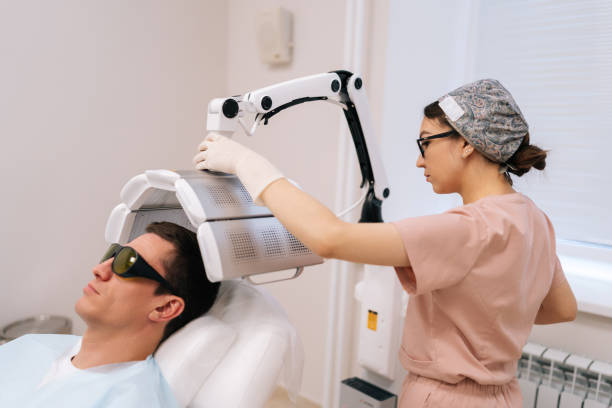The COVID-19 pandemic altered the course of our lives in countless ways. While vaccines have played a critical role in protecting communities, boosting immunity, and reducing hospitalizations, some people have reported unexpected after effects—one of them being hair loss.
Globally, over 13 billion COVID vaccine doses have been administered, according to WHO data. In India alone, the Ministry of Health and Family Welfare reports more than 2.2 billion doses given as of 2025. Alongside the relief from severe infection, some recipients noticed temporary hair thinning or increased shedding, raising questions and concerns.

Dr. Harikiran Chekuri, a celebrated hair transplant specialist in Hyderabad, shares:
“Hair loss after COVID vaccination is generally a temporary phenomenon, often triggered by the body’s immune and inflammatory responses. It is not the vaccine directly harming the follicles but rather the way our system reacts to stress, inflammation, or changes in immunity. Understanding the root cause can help patients approach the situation calmly and with a clear treatment plan.”
So, what’s actually happening beneath the surface? Let’s uncover the real triggers behind this unexpected shedding.
Causes of Hair Loss Due to Vaccine
Hair loss after vaccination is not classified as a direct side effect but rather a temporary reaction in certain individuals. The most common type seen in such cases is telogen effluvium, where more hair than normal goes into the resting phase of the growth cycle. Here’s why it happens:

Immune System Response
The vaccine stimulates your immune system to produce antibodies. This immune activity can release inflammatory chemicals that may briefly affect hair follicle function.
Physiological Stress
Any medical intervention, even a vaccine, can cause short-term stress on the body. For some, this stress pushes hair into a shedding phase a few weeks later.
Fever or Post-Vaccine Illness
Fever, fatigue, or body aches after the shot can disrupt the hair growth cycle, similar to how illness-related shedding occurs.
Underlying Deficiencies
Iron, vitamin D, and protein deficiencies—common in Indian diets—may exacerbate hair loss once the body undergoes an immune challenge.
Hormonal Fluctuations
In some women, the stress of vaccination and immune activation may mildly affect hormonal balance, triggering temporary thinning.
Dr. Harikiran Chekuri, a prominent cosmetic surgeon in Hyderabad, notes:
“We often see hair loss cases following major stress events—be it surgery, illness, or even emotional upheaval. The vaccine simply acts as one such trigger. The good news is, with the right care, this shedding is usually reversible within a few months.”
Hair loss can happen both after vaccination and after COVID infection—but the reasons aren’t quite the same. Here’s how they compare.
Vaccine vs. Infection Hair Loss
While both vaccine-related and infection-related shedding can look similar, the mechanisms differ:
Post-Vaccine Hair Loss
- Usually triggered by immune activation or short-term stress.
- More likely to be mild to moderate.
- Appears within 4–8 weeks post-vaccination.
Post-COVID Infection Hair Loss
- Linked to high fever, severe inflammation, and the body’s fight against the virus.
- Often more intense and widespread.
- Can persist longer if overall health remains affected.
Interestingly, studies published in the Journal of the American Academy of Dermatology indicate that post-infection hair loss affects around 20–25% of patients, whereas vaccine-related cases are significantly less common.
Dr. Harikiran Chekuri, a distinguished hair transplant specialist in Hyderabad, explains:
“With infection-related shedding, the body undergoes prolonged stress, and nutrient depletion is more severe. Vaccination-related shedding, on the other hand, is a shorter event, and the follicles typically recover quickly with minimal intervention.”
If the shedding has already begun, the focus should shift toward recovery and preventing further loss.
How to Treat COVID Vaccine Hair Loss
Most cases of COVID Vaccine Hair Loss resolve on their own within 3–6 months. However, supportive care can accelerate recovery and improve hair health:

Nutritional Optimization
Ensure adequate intake of iron, zinc, biotin, and protein.
Indian diets low in animal protein may require supplementation.
Topical Treatments
Minoxidil can help stimulate follicles to re-enter the growth phase.
Gentle scalp massage improves blood circulation.
Medical Evaluation
Rule out thyroid disorders, anemia, or other underlying triggers.
Blood tests can guide targeted supplementation.

Low-Level Laser Therapy
LLLT is a non-invasive treatment that encourages follicle activity and speeds up recovery.
Stress Management
Meditation, yoga, and adequate sleep reduce cortisol levels, which can otherwise worsen shedding.
PRP (Platelet-Rich Plasma) Therapy
PRP is a minimally invasive option where your own platelets are used to stimulate hair regrowth.
Dr. Harikiran Chekuri, a trusted hair transplant surgeon in Hyderabad, advises:
“The aim is not to panic but to respond strategically. Early intervention, whether through medical therapies, nutritional correction, or lifestyle changes, can make a significant difference in recovery timelines. Even in severe cases, modern treatments can restore density effectively.”
Now that we’ve discussed causes and treatments, let’s tie it all together.
Conclusion
COVID Vaccine Hair Loss is generally temporary and manageable. While it may come as an unwelcome surprise, understanding the underlying causes and knowing that hair typically regrows can help ease anxiety. With proper nutrition, supportive treatments, and stress management, recovery can be smooth and complete.
And if you still have questions, you’re not alone—here are answers to some of the most common concerns.


